Delhi
|
Delhi, capital city of the Federal Republic ofIndia. It is one of India's fastest growing cities. It has sprawled over the West Bank of the river Yamuna, straddling the river. The city has two distinct parts, Old Delhi & New Delhi. Old Delhi is centered on the Red Fort built by Emperor Shah Jehan between 1636 & 1658.
The streets of Old Delhi are narrow & bustling. The beauty & serenity lies inside the courts of the main buildings. Delhi has some of the finest museums in the country. Its boutiques and shopping arcades offer access to a wealth of traditional and contemporary crafts, from all over the country. New Delhi was proclaimed the capital of India by the British architect Sir Edwin Lutyens (1869-1944), & is tree-lined & spacious.
|
General Information
|
Capital - New Delhi. Area: 491 sq km.
Language - Hindi, Punjabi, Urdu, English is equally in the use.
Best Season-For Sightseeing, the best season to visit Delhi is between October to March. |
Tourism Spots
|
| India Gate |
| The India Gate is the national monument of India. Situated in the heart of New Delhi, India Gate was designed by Sir Edwin Lutyens. Originally known as All India War Memorial, it is a prominent landmark in Delhi and commemorates the 90,000 soldiers of the British Indian Army who lost their lives while fighting for the British Indian Empire, or more correctly the British Empire in India British Raj in World War I and the Third Anglo-Afghan War. It is composed of red sand stone and granite. |
|
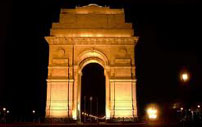 |
|
| |
| Rashtrapati Bhavan |
| The Rashtrapati Bhavan (Sanskrit for Presidential House/Palace) is the official residence of the President of India, located in New Delhi, Delhi, India. Until 1950 it was known as "Viceroy's House" and served as the residence of the Viceroy of India. It is at the heart of an area known as Lutyens' Delhi. It is the largest residence of any Head of the State in the world. |
|
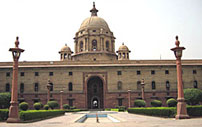 |
|
| |
| Laxminarayan Temple |
| The Laxminarayan Temple ( also known as the Birla Mandir) is a Hindu temple dedicated to Laxminarayan in Delhi, India. The temple is built in honour of Laxmi (Hindu goddess of wealth), and her consort Narayana (Vishnu, Preserver in the Trimurti). The temple is adorned with many shrines, fountains, and a large garden. The temple is one of the major attractions of Delhi and attracts thousands of devotees on the Hindu festivals of Janmashtami and Diwali. |
|
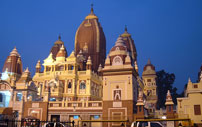 |
|
| |
| Akshardham Temple |
| Akshardham is a Hindu temple complex in Delhi, India Also referred to as Delhi Akshardham or Swaminarayan Akshardham, the complex displays centuries of traditional Indian and Hindu culture, spirituality, and architecture. The building was inspired and moderated by Pramukh Swami Maharaj, the spiritual head of the Bochasanwasi Shri Akshar Purushottam Swaminarayan Sanstha, whose 3,000 volunteers helped 7,000 artisans construct Akshardham. |
|
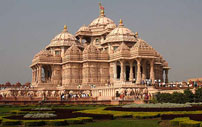 |
|
| |
| Gurudwara Bangla Sahib |
| Gurudwara Bangla Sahib is the most prominent Sikh gurdwara, or Sikh house of worship, in Delhi, known for its association with the eighth Sikh Guru, Guru Har Krishan, and the pond inside its complex, known as the "Sarovar", whose water is considered holy by Sikhs and is known as "Amrit". It was built by Sikh General, Sardar Bhagel Singh in 1783, who supervised the construction of nine Sikh shrines in Delhi in the same year, during the reign of Mughal Emperor, Shah Alam II . |
|
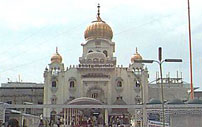 |
|
| |
|
Humayun's tomb |
| Humayun's tomb (Humayun ka Maqbara) is a complex of buildings built as the Mughal Emperor Humayun's tomb, commissioned by Humayun's wife Hamida Banu Begum in 1562 CE, and designed by Mirak Mirza Ghiyath, a Persian architect.[1] It was the first garden-tomb on the Indian subcontinent, and is located in Nizamuddin East, Delhi, India, close to the Dina-panah citadel also known as Purana Qila, that Humayun founded in 1533. |
|
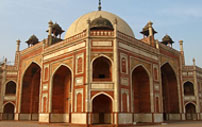 |
|
| |
| Qutb Minar |
| The Qutb Minar tower in Delhi, India, is at 72.5 meters (237.8 ft) the world's tallest brick minaret. Construction commenced in 1193 under the orders of India's first Muslim ruler Qutb-ud-din Aibak, The Qutb Minar is notable for being one of the earliest and most prominent examples of Indo-Islamic architecture. It is surrounded by several other ancient and medieval structures and ruins, collectively known as Qutb complex. Qutub Minar draws most tourists |
|
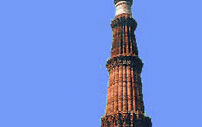 |
|
| |
| Red Fort |
| The Red Fort (usually transcribed into English as Lal Qil'ah or Lal Qila) is a 17th century fort complex constructed by the Mughal emperor Shah Jahan in the walled city of Old Delhi (in present day Delhi, India). It served as the capital of the Mughals until 1857, when Mughal emperor Bahadur Shah Zafar was exiled by the British Indian government. The British used it as a military camp until India was made independent in 1947. |
|
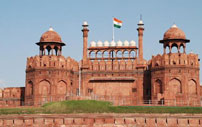 |
|
| |
| Chandni Chowk |
| Chandni Chowk (originally meaning moonlit square or market, is one of the oldest and busiest markets in Old Delhi, now in central north Delhi, India. |
|
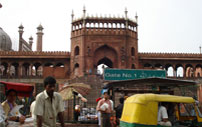 |
|
| |
| Jama Masjid |
| The Masjid-i Jahan-Numa (The 'World-reflecting Mosque'), commonly known as the Jama Masjid of Delhi, is the principal mosque of Old Delhi in India. Commissioned by the Mughal Emperor Shah Jahan, builder of the Taj Mahal, and completed in the year 1656 AD, it is the largest and best-known mosque in India. It lies at the origin of a very busy central street of Old Delhi, Chandni Chowk. The later name, Jama Masjid, is a reference to the weekly Friday noon congregation prayers of Muslims, Jummah, which are usually done at a mosque, the "congregational mosque" or "jami' masjid". |
|
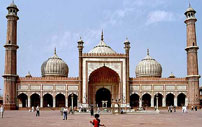 |
|
| |
| Raj Ghat |
| Raj Ghat is a memorial to Mahatma Gandhi. It is a black marble platform that marks the spot of Gandhi's cremation on 31 January 1948. It is left open to the sky while an eternal flame burns perpetually at one end. It is located on the banks of the river Yamuna in Delhi in India on Ring Road officially known as Mahatma Gandhi Road. A stone footpath flanked by lawns leads to the walled enclosure that houses the memorial. Two museums dedicated to Gandhi, including the National Gandhi Museum, are located near |
|
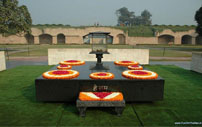 |
|
| |
| ShantiVan |
| Lying close to the Raj Ghat, the Shanti Vana (literally, the forest of peace) is the place where India's first Prime Minister Jawaharlal Nehru was cremated. The area is now a beautiful park adorned by trees planted by visiting dignitaries and heads of state. |
|
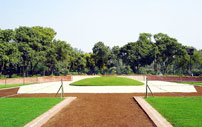 |
|
| |
| Lotus Temple |
| The Bahá'í House of Worship in Delhi, India, popularly known as the Lotus Temple due to its flowerlike shape, is a Bahá'í House of Worship and also a prominent attraction in Delhi. It was completed in 1986 and serves as the Mother Temple of the Indian subcontinent. It has won numerous architectural awards and been featured in hundreds of newspaper and magazine articles |
|
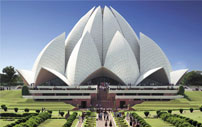 |
|
| |
| Purana Qila |
| Purana Qila ( translation: Old Fort), is the oldest fort of Delhi, also known as "Pandovon Ka Quila". Pandavs were the rulers of Hastinapur (Delhi) during the times of Mahabharat War some 5000 years ago. The other two forts of Delhi are 'Tughlakabad Fort' and 'Lal Quila' Recent excavations in Purana Quila, unearthed artefacts as old as the period of 1000 BCE. It is also the Fort, where the last Hindu Emperor of India, Samrat Hem Chandra Vikramaditya had his coronation after defeating the forces of Mughal King Akbar in the year 1556. |
|
 |
|
| |
| Sansad Bhavan |
| The Parliament of India is the supreme bicameral legislative body of the federal government of the Republic of India. It consists of the office of President of India and two Chambers, the House of People, known as the Lok Sabha and the Council of States, known as the Rajya Sabha. The Members of either house are commonly referred to as Member of Parliament or MP. |
|
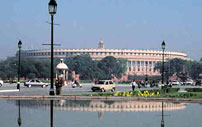 |
|
| |
| National Museum |
| The National Museum in New Delhi is the largest museum in India. It holds variety of articles ranging from pre-historic era to modern works of art. It functions under the Ministry of Culture, Government of India. The museum is situated on the corner of Janpath and Maulana Azad Road. [1]
It also houses the National Museum Institute of History of Art, Conservation and Museology established in 1983 and now a Deemed University since 1989, and run Masters and Doctoral level courses in History of Art, Art Conservation and Art restoration. |
|
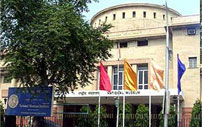 |
|
| |
| Connaught Place |
| Connaught Place (officially Rajeev Chowk) is one of the largest financial, commercial and business centers in Delhi. It is often abbreviated as CP and houses the headquarters of several Indian firms. Its surroundings occupy a place of pride amongst the heritage structures of the city. It was developed as a showpiece of Lutyens' Delhi featuring a Central Business District. Named after the Duke of Connaught, the construction work was started in 1929 and completed in 1933. It was renamed as the Rajeev Chowk after the late Indian Prime Minister Rajiv Gandhi.The Connaught Place of today is one of the most vibrant business districts of Delhi. |
|
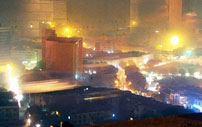 |
|
| |


















